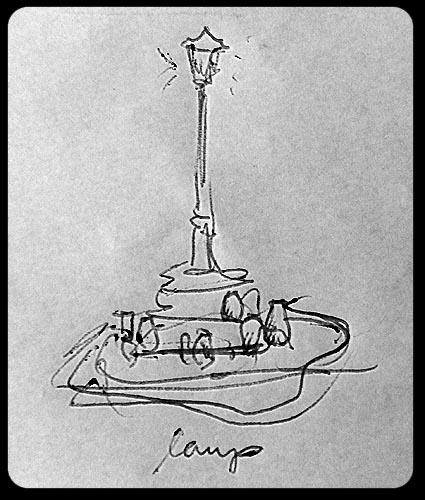I'm about to start an extensive terrain project. The goal is to build a collection of
graveyard-themed terrain – walls, fence, tombstones and so on, to choose from
when setting up a cemetery board for my games. I haven’t set a deadline, but I expect
I’ll be working on this for the next few months. I’m planning to eventually do
the same for each of the different environments I wrote about in my last post.
I recently bought a used Garden of Morr set,
assembled and cleaned up (more or less) by its previous owner. However, it will
require a lot of work to look proper- from filling gaps to getting rid of all
those annoying skulls. Yes, it is a graveyard and all, and I’ve seen catacombs
and charnel houses we have in the real world that are covered in way more bones
than this, but that doesn’t make GW’s design any less tacky. The Citadel set
will be combined with some scratch-built stuff.
 |
| I’ve done a bit of shopping for other materials
I’ll need before I start. |
I have a general idea of what I want to do, so let
me just describe the plan in brief.
*
Three musoleums. These came in the Garden of Morr
set, and for starters need some gap filling and minor de-skulling. The graves
sculpted on their bases will probably need to go, and I’ll add my own details, such
as vases and urns. All in all, I think these are the best part of the Garden of
Morr set.
*
Walls, fence and gate. Way too many skulls here,
and some of those spikes will go as well.
I am also planning to make some walls of my own from scratch. And when I
wish to represent a rural graveyard I can use the wooden fence I already have.
*
Monument. The skulls in the floor should be covered
up. The grim statue will probably require some minor conversion. And I will
definitely make more similar pieces – crucifixes and small shrines that can
stand in the graveyard or by the field or on the crossroads.
*
Tombstones. Can’t have a cemetery without those. I
haven’t bought any yet, but I think the plastic grave markers from Renedra will
do very well. I can combine them with wooden crosses made from scratch. These
will be based in a combination of different ways- some in groups as area
terrain, some in straight rows and some as single graves.
*
Assorted flavour terrain: lamp posts, coffins,
plague pit, stunted trees...
*
And there are a couple pieces I already made ages ago which fit the graveyard theme. There is the old cemetery (I'll put some more work into this to make it prettier) and the chapel (still looking good; perhaps it could use a rebasing). I’ll also need a full-size church, but that will be a separate little project
in the future.
*
I will definitely get more into detail as I go
along. The entire build and painting will be documented and published here in a
series of tutorials so it can be useful for everyone. I’m looking forward to
working on this.
* * *
In the end, a few lines of random fluff. This time it's
about the Fair Folk:
Fairy taint is the name for
the harmful radiation that emanates from all Fae creatures. The intensity
of radiation varies from one fairy to another, and even a single one will not
radiate equally at all times. The taint lingers behind them wherever they go,
and remains in any living thing they encounter. The contamination will,
however, diminish by itself with time (depending on the dose absorbed).
Prolongued exposure to the Fae causes fairy taint to build up in the body.
Smaller doses may cause nausea, tremor or light-headedness. If a
sufficiently large dose is accumulated it usually has damaging effects. A
heavily tainted person or animal will eventually display some or all of the
following symptoms:
- Loss of appetite
- Weariness
- Insomnia
- Unusual aversion to iron
- Social withdrawal
- Lethargy
- Hallucinations (such as hearing voices)
- Disorganized thinking and speech
- Infantility
- Catatonia
- Amnesia
- Glowing eyes, pale complexion
- Low body temperature
- Enfatuation with Fae creatures
- Thin bluish smoke coming out of orifices, often paired with fits of
cough
- Blindness
- Undying urge to get up and walk deep into the woods or to throw
oneself into a well
- Obedience to the higher Fae
- Death
Iron absorbs and neutralizes fairy taint, and repels the Fae by causing them discomfort. This is the
reason why village folk will customarily nail an old horseshoe above the door of their
cottage.





































